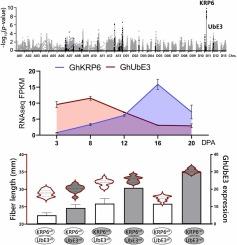当前位置:
X-MOL 学术
›
Ind. Crops Prod.
›
论文详情
Our official English website, www.x-mol.net, welcomes your
feedback! (Note: you will need to create a separate account there.)
Interaction of the cyclin-dependent kinase inhibitor GhKRP6 with RING-Type E3 ligase influences the fiber length in Upland cotton
Industrial Crops and Products ( IF 5.6 ) Pub Date : 2024-10-12 , DOI: 10.1016/j.indcrop.2024.119789
Marina Naoumkina , Gregory N. Thyssen , Linghe Zeng , Jay Shockey , Nicholas Neumann , Christopher B. Florane , Johnie N. Jenkins , Jack C. McCarty , David D. Fang
Industrial Crops and Products ( IF 5.6 ) Pub Date : 2024-10-12 , DOI: 10.1016/j.indcrop.2024.119789
Marina Naoumkina , Gregory N. Thyssen , Linghe Zeng , Jay Shockey , Nicholas Neumann , Christopher B. Florane , Johnie N. Jenkins , Jack C. McCarty , David D. Fang

|
Upland cotton (Gossypium hirsutum L.) is the major crop producing renewable fiber for textiles. Cotton fiber length is an economically important trait that affects the quality of the yarn. The Upland cotton multi-parent advanced generation intercross (MAGIC) population was developed for genetics research to understand how fiber traits can be improved without reducing fiber yield. A genome-wide association study of the MAGIC population identified a significant fiber length QTL on Chromosome D11 (qFL-D11–1). To understand how the qFL-D11–1 regulates fiber length, we developed F5 lines by crossing the longest and the shortest fiber recombinant inbred lines (RILs) of the MAGIC population to establish lines with parental haplotypes at the qFL-D11–1 but segregating for other loci. The F5 lines and parental RILs were sequenced to detect exchanges from parents' genomic regions in the progeny. One segregating genomic region in the F5 lines coincided with qFL-D12–1, which additively affected fiber length. Correlation analysis of the expression patterns of genes from the two QTLs with the fiber lengths in the MAGIC population showed the highest correlation of the RING-type ubiquitin E3 ligase (GhUbE3) from qFL-D12–1. Kip-related protein-6 (KRP6) is the candidate gene from the qFL-D11–1. A yeast two-hybrid and bimolecular fluorescence complementation assays demonstrated a physical interaction between GhKRP6 (Ghir_D11G020340) and GhUbE3 (Ghir_D12G006080). RNAseq showed that the GhUbE3 expression is reciprocal to the interacting GhKRP6 during fiber development. Virus-induced gene silencing (VIGS) of GhKRP6 increased fiber length. The data indicates that GhUbE3 controls the dose of GhKRP6's inhibitory activity and, therefore, the duration of fiber elongation.
中文翻译:

细胞周期蛋白依赖性激酶抑制剂 GhKRP6 与 RING 型 E3 连接酶的相互作用影响陆地棉的纤维长度
陆地棉 (Gossypium hirsutum L.) 是生产用于纺织品的可再生纤维的主要作物。棉纤维长度是影响纱线质量的重要经济特性。陆地棉多亲代高级一代杂交 (MAGIC) 种群是为遗传学研究而开发的,旨在了解如何在不降低纤维产量的情况下改善纤维性状。一项针对 MAGIC 群体的全基因组关联研究在染色体 D11 (qFL-D11-1) 上发现了一个显著的纤维长度 QTL。为了了解 qFL-D11-1 如何调节纤维长度,我们通过杂交 MAGIC 群体中最长和最短的纤维重组自交系 (RIL) 来开发 F5 系,以建立在 qFL-D11-1 处具有亲本单倍型但分离其他基因座的系。对 F5 系和亲本 RILs 进行测序,以检测来自后代亲本基因组区域的交换。F5 系中的一个分离基因组区域与 qFL-D12-1 重合,后者累加地影响纤维长度。两个 QTL 基因的表达模式与 MAGIC 群体中纤维长度的相关性分析显示,qFL-D12-1 的 RING 型泛素 E3 连接酶 (GhUbE3) 的相关性最高。Kip 相关蛋白-6 (KRP6) 是 qFL-D11-1 的候选基因。酵母双杂交和双分子荧光互补测定表明 GhKRP6 (Ghir_D11G020340) 和 GhUbE3 (Ghir_D12G006080) 之间存在物理相互作用。RNAseq 显示,在纤维发育过程中,GhUbE3 表达与相互作用的 GhKRP6 呈倒数关系。 GhKRP6 的病毒诱导基因沉默 (VIGS) 增加了纤维长度。数据表明,GhUbE3 控制 GhKRP6 抑制活性的剂量,因此控制纤维伸长的持续时间。
更新日期:2024-10-12
中文翻译:

细胞周期蛋白依赖性激酶抑制剂 GhKRP6 与 RING 型 E3 连接酶的相互作用影响陆地棉的纤维长度
陆地棉 (Gossypium hirsutum L.) 是生产用于纺织品的可再生纤维的主要作物。棉纤维长度是影响纱线质量的重要经济特性。陆地棉多亲代高级一代杂交 (MAGIC) 种群是为遗传学研究而开发的,旨在了解如何在不降低纤维产量的情况下改善纤维性状。一项针对 MAGIC 群体的全基因组关联研究在染色体 D11 (qFL-D11-1) 上发现了一个显著的纤维长度 QTL。为了了解 qFL-D11-1 如何调节纤维长度,我们通过杂交 MAGIC 群体中最长和最短的纤维重组自交系 (RIL) 来开发 F5 系,以建立在 qFL-D11-1 处具有亲本单倍型但分离其他基因座的系。对 F5 系和亲本 RILs 进行测序,以检测来自后代亲本基因组区域的交换。F5 系中的一个分离基因组区域与 qFL-D12-1 重合,后者累加地影响纤维长度。两个 QTL 基因的表达模式与 MAGIC 群体中纤维长度的相关性分析显示,qFL-D12-1 的 RING 型泛素 E3 连接酶 (GhUbE3) 的相关性最高。Kip 相关蛋白-6 (KRP6) 是 qFL-D11-1 的候选基因。酵母双杂交和双分子荧光互补测定表明 GhKRP6 (Ghir_D11G020340) 和 GhUbE3 (Ghir_D12G006080) 之间存在物理相互作用。RNAseq 显示,在纤维发育过程中,GhUbE3 表达与相互作用的 GhKRP6 呈倒数关系。 GhKRP6 的病毒诱导基因沉默 (VIGS) 增加了纤维长度。数据表明,GhUbE3 控制 GhKRP6 抑制活性的剂量,因此控制纤维伸长的持续时间。



































 京公网安备 11010802027423号
京公网安备 11010802027423号